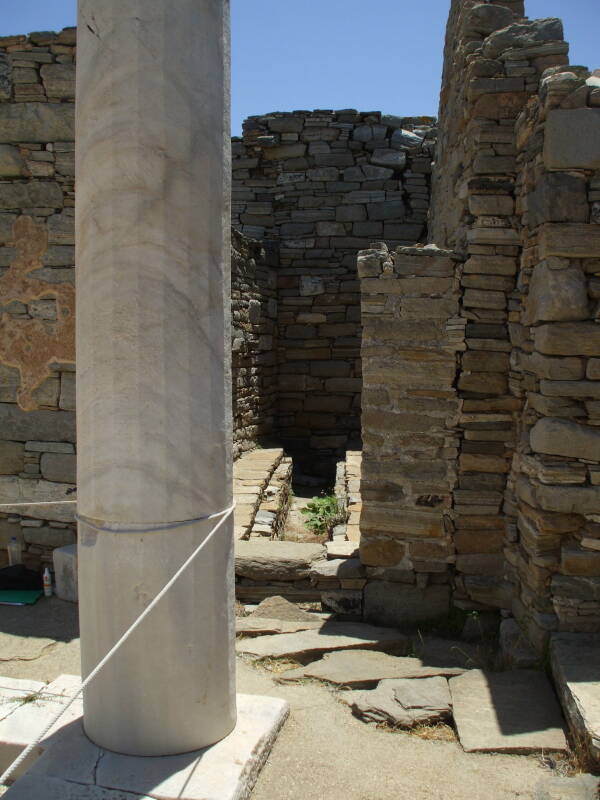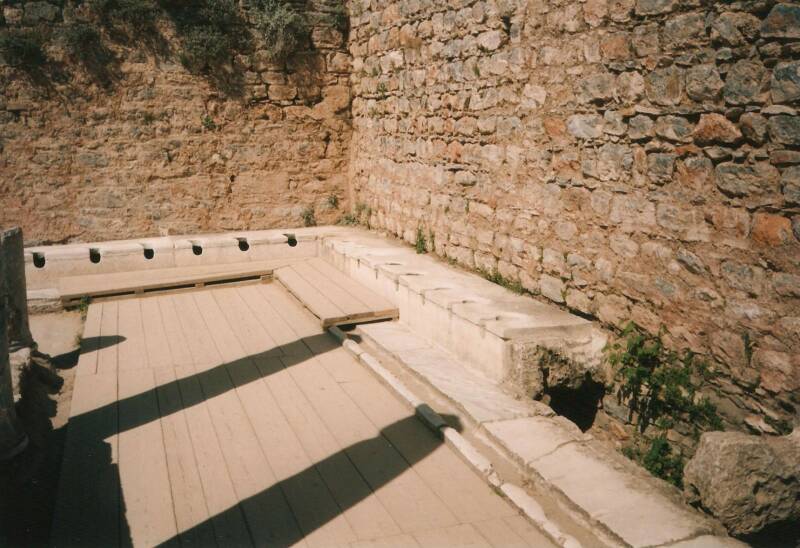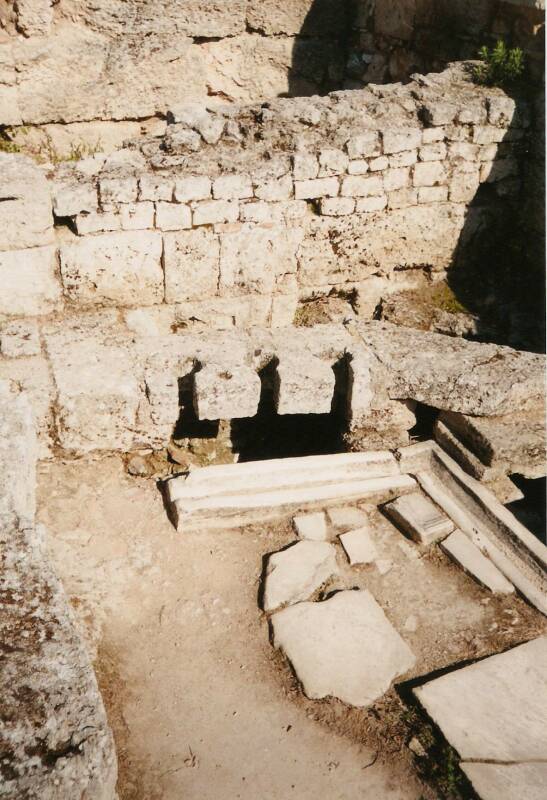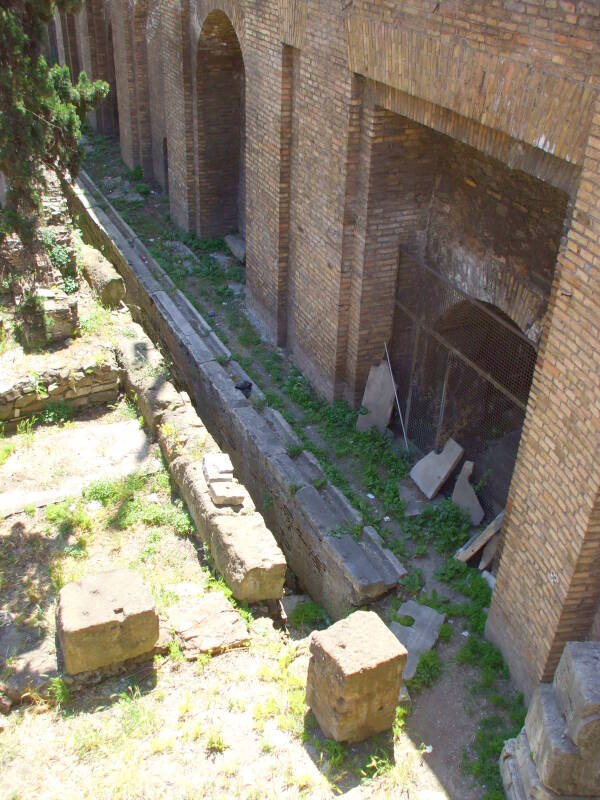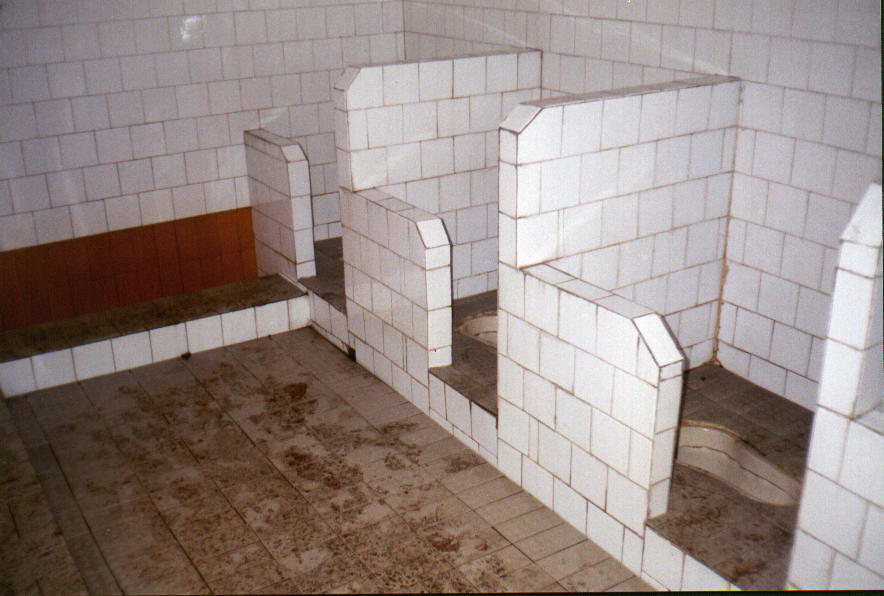
Public Toilets, Private Space, and Gender
Public Toilets Appear, Disappear, Reappear, and Become Complicated
Toilets with some form of community plumbing
have been around at least since
3180 BC.
As permanent communities organized,
they developed shared sanitation infrastructure.
Initially it seems to have been limited to common
infrastructure, shared drains for private toilets.
Later, especially in Greek and Roman society,
true public toilets appeared.
These were facilities for multiple simultaneous users
from the general population.
At least in Europe, these largely disappeared
as the Western Roman Empire faded away.
Public toilets began reappearing in the early 1800s,
and became segregated by gender in the late 1800s.
The traditional gender separation of public toilets
began causing controversy in the 2010s.
How were public toilets developed?
Why did they disappear?
When did they come back?
When did the custom of separating public toilets by sex happen?
Read on to find out!
Early Developments in West Asia and Europe
The Neolithic-era Skara Brae settlement in Orkney, off the northern coast of Scotland, is a cluster of eight dwellings that were occupied roughly 3180-2500 BC. The dwellings were built adjacent to one another, connected with narrow curving passageways. Each single-family dwelling consists of one large room subdivided into sleeping, hearth, and storage areas. A small chamber off one corner of this room is thought to be a toilet, associated with a shared drainage system.
The drainage system could have handled liquid waste only. Solid waste would have to be carried outdoors, and more likely the inhabitants simply defecated outdoors except when weather made that impractical.
These toilets are quite private, located within a single-family dwelling and even providing a degree of privacy within the family. The community had to cooperate to build the drainage system, but it was a shared infrastructure only.
The cities of Harappa and Mohenjo-daro in the Indus Valley Civilization had flush toilets in most homes connecting to a common sewage disposal system as early as 2600 BC. Again, it was a shared public infrastructure. As far as I have seen, the toilets were all individual private ones.
By 2400 BC, the Northern Palace in Eshnunna in Mesopotamia had a latrine with seven holes cut in a stone bench. This is the earliest example I know of for a latrine with multiple simultaneous users. Shared but not public, as it was within the palace. A typical Mesopotamian latrine was based on a cesspit about 4.5 meters deep, with a lining formed by a stack of ceramic flat rings with an inner diameter of about a meter. Liquid seeped out through perforations in the rings. Solid waste stayed in the pit and required re-excavation every few years. Only a small percentage of private homes had one of these toilets. Most of the population would have used chamber pots or squatted in fields.
Mycenae, or Μυκήνες in Greek, was first settled by Neolithic people in the 6th millennium BC. From about 2100 to 1900 BC during the Old Bronze Age, Indo-European people crossed Anatolia, moved through Troy, and continued across the Dardanelles to the west and then south through Greece, establishing small kingdoms. The kingdom of Mycenae became the most powerful of these by a wide margin, leading to the entire civilization of that area and time being called Mycenaean. For the 400 years from 1600 to 1200 BC, Mycenae was the most powerful kingdom in Greece.
The nearby kingdom of Tiryns (or Τίρυνς) reached its height in 1400 to 1200 BC. Homer referred to it as "wall-girt Tiryns" and "mighty-walled Tiryns". It was built on a limestone outcropping about twenty meters high, with enormous walls built on top of that. The walls were up to twenty meters thick and built from stones weighing up to 14 tons, making it nearly impregnable. The entire complex is 300 meters long and 45 to 100 meters wide, with half of that an upper level occupied by a palace. The other end of the complex, where the interior ground is lower, seems to be the site of a multi-person latrine.

Apparent latrine and drain in the citadel of Tiryns.

Apparent latrine and drain in the citadel of Tiryns.
A Neolithic settlement in Vietnam, about 30 kilometers south of today's Ho Chi Minh City (or Saigon), includes what researchers describe as "Vietnam's earliest latrine" dating to 1700-1300 BC, although it isn't clear from the descriptions that there was any structure, let alone sanitary plumbing.
VisitingHa-at-tu-ša
The Hittite Empire diminished and then its capital in Anatolia collapsed around 1200 BC. The Phrygian people had moved out of the southern Balkans into Anatolia when Troy was at the height of its power. They were just tribal village dwellers when they first arrived in Anatolia, but they established a powerful state over the following centuries of approximately 1200 to 700 BC. Their city at the former Hittite capital of Ha-at-tu-ša included a system of drains to carry away sewage.
VisitingDelos
There were flushing toilets in the royal palaces in Minos, on Crete, but nothing for the common people, at least not initially. A 44-seat latrine was built in the Minoan palaces around 600 BC, but it was only for use by the royal family and gatherings of nobility.
The Greeks on the sacred island of Delos or Δήλος had large-scale public plumbing in addition to private latrines flushed by running water in the period from 900 BC to 100 AD.

This sewage drain dates from the Phrygian settlement of Ha-at-tu-ša about 1200-700 BC.
Toilets Become Public
By the time of Classical and Hellenistic Greece (approximately 500 to 320 BC and 320 to 140 BE, respectively) more and more shared public toilet facilities were appearing in public baths. The Roman Empire (27 BC onward, following 5 centuries of the Roman Republic) expanded and administered culturally Greek homelands and colonies all around the Mediterranean. The Romans undertook many elaborate hydraulic engineering projects, and there was an increase in the number of public toilets, especially connected to or near public baths.
Roman plumbing was impressive for its time, but it wasn't a cure-all. A 2015 study in Parasitology found that intestinal parasites including whipworm (Trichuris trichiura), roundworm (Ascaris lumbricoides), fish tapeworm, and the dysentery-causing Entamoeba histolytica became more common when Romans arrived in an area. The Roman use of collected human feces as fertilizer increases the prevalence of parasites like roundworm, whipworm, and tapeworm.
A mansio was an official stopping place along a via or Roman road. A caupona was a private business functioning like a mansio but unofficial and somewhat disreputable. A taberna was a hostel for travelers. The mansio and caupona would typically have a tavern, a bath, and a shared latrine or forina. The non-elite locals would have frequented the caupona and used its shared latrine. Meanwhile the elite would have met with friends (and defecated) at home, where their slaves would bring, take away, and clean chamber pots.
The Romans saw no need for privacy while defecating, even with men and women sharing one large latrine. You hitched up your toga, sat down, and let it drape down around you. A small channel of water ran past your feet, to wet and wash the tersorium, also called a xylospongium, a sponge on a stick that you used to clean yourself. There would be a small shrine, probably to Fortuna, the general-purpose goddess of good luck, asking her to help those using the facility. And there were plenty of fellow citizens to chat with.
Above: Public latrine at Ephesus (or Έφεσος) in Asia Minor.
Here: Public latrine at Corinthos (or Κόρινθος) in Greece.
Below are two views of a public latrine in Hierapolis (or Ίεράπολις) in Asia Minor, and a large latrine near the Senate in Rome.
A small latrine would be just one or maybe a few seats over a cesspit in which solid waste collected. The odor and clouds of flies would be oppressive. The cesspit latrine in a home would typically be in the kitchen, so it could also receive food preparation waste. But a well-designed large public latrine could be quite pleasant and serve as a social space. Flowing water beneath the seats would wash away the waste, and windows would bring plenty of light and fresh air.
As far as I can tell, large public latrines were not all divided by sex. The baths were, there would be one bath for men and another for women, each with their own multi-user latrine. The Roman Senate was male-only, and so the Senate latrine was male-only. But from what I've read, it seems that the large public latrines in the Roman world weren't all segregated by sex.
The elite Romans had privacy, to the degree they cared about the concept. The chamber pot was handled by a slave, just a slave and not a real person. The important thing for the elite was that this brought no risk of encountering any of the wrong people who might be hanging around down at the caupona.
This pattern of privacy for the elite only, with everyone else urinating and defecating in mixed-sex groups of strangers, continued in Europe into the 1800s and the arrival of mass-produced commodes connected to sewers. Privacy for everyone had to wait until toilets were installed in lower-class dwellings (shared, but in a small compartment occupied by just one person at a time) and in public facilities resembling the modern design with individual stalls.
Power, Privilege, and PrivacyThe rules were different for royalty. Power brought privilege, including freedom from any need to care about privacy. Rulers were above petty humanity, they could defecate or engage in any other bodily function whenever and wherever they wanted, as the rules of mass society did not apply. U.S. President Lyndon Johnson was a rare 20th century ruler who lived by this Bronze Age code of behavior.
The Roman Empire split and then rapidly faded in the west. The Gothic War began in 376 AD, and a century later Odoacer deposed the Emperor Romulus Augustulus in 476, an event traditionally considered as marking the end of the Western Roman Empire. That brought an end to most civil engineering projects, including sanitation. There had been hundreds of public latrina and neccessaria in Rome, but they fell into disuse and disrepair. The Roman sewer systems like the Cloaca Maxima or Great Sewer required frequent cleaning. The waste would back up into the shared latrina within a few years of the end of public administration and maintenance.
To the east, Baghdad had nearly 60,000 bathhouses with associated toilets at the height of its prosperity. In the 8th and 9th centuries AD, Baghdad probably had the largest population of any city in the world. It was a center of learning and commerce. Europeans traveled to west Asia from 1096 to 1291 during the Crusades. The survivors took the ideas of steam baths and both public and personal hygiene back home with them.
For a while, steam baths were popular in England. Apparently men and women bathed together, according to early paintings and prints (although many of the images probably were either criticizing or commemorating the semi-open prostitution associated with many of the bathhouses). People socialized and even ate meals in the "stews". There would have been some associated toilets, at least chamber pots and shared cesspits. But the bath craze didn't last.
Public Toilets Disappear From Europe
The Bubonic Plague hit Europe in 1347, and people came to widely believe that bathing or any other exposure of the body to water led immediately to disease.
There were just a handful of public toilets in all of Europe in the 1300s. There is mention of just one each in Frankfurt in 1348, London in 1383, and Basel in 1455. Christian religious communities had shared neccessaria, as seen in my examples from southern France, England, and Scotland, but these were for the monastic community, not the general public.
Medieval cities had some garderobes. This was a wooden or stone seat with a hole, typically situated on a bridge over a river or moat.
Spanish salmonella versus the AztecsStreets throughout Europe were open sewers in the early 1500s. The Spanish explorers reached the Americas and were amazed to find enormous cities with highly effective waste disposal systems. They brought back all the precious metals they could seize while disregarding the valuable ideas about sanitation.
The Once-Common Practice of Communal SleepingAtlas Obscura
Common people had little to no privacy even at home. Entire families slept in a single bed if they could afford it, or wrapped in the same blankets if not. Any servants likely slept nearby. Travelers in inns shared beds. Victorian England led the move in the mid to late 1800s toward separate bedrooms for each family member, with married couples having separate beds in a shared room. As we will see below, they also had rather obsessive toilet regulations.
England had at least 13 houses of easement during the Tudor period (1485-1603). These were communal privies for the lower class, frequently located on bridges over streams. "Whittington's Longhouse", named for the mayor of London, had 84 seats. It was located on a stream feeding into the Thames. It was destroyed in the Great Fire in 1666 and rebuilt on a smaller scale. The stream is gone today, at least as seen from the surface. The location is called Walbrook Street.
In 1519 the government of Normandy formally required toilets in homes, and the national parliament of France required cesspits in all houses. These measures didn't have the desired effects, attempts were made again in 1539. About the same time, Bordeaux legally required cesspits. But people kept throwing most of their waste into the streets.
The middle class had chamber pots and dumped the contents into the street or river. King Henry VIII built a 28-seat Great House of Easement at his Hampton Court Palace in 1540.
Meanwhile in India in 1556, the Mughal King Jehangir built a public toilet for 100 families in Alwar, 120 kilometers from Delhi.
The surviving public baths in England became less popular in the late 1500s as public opinion increasingly associated them, accurately or not, with brothels. King Henry VIII shut down all the public bathhouses in England in 1546, blaming them for the seven waves of plague that had hit England over the preceding 200 years.
Public latrines with cesspits became significant sources of human waste used as crop fertilizer and as the raw material for potassium nitrate or saltpeter, KNO3, an ingredient of gunpowder.
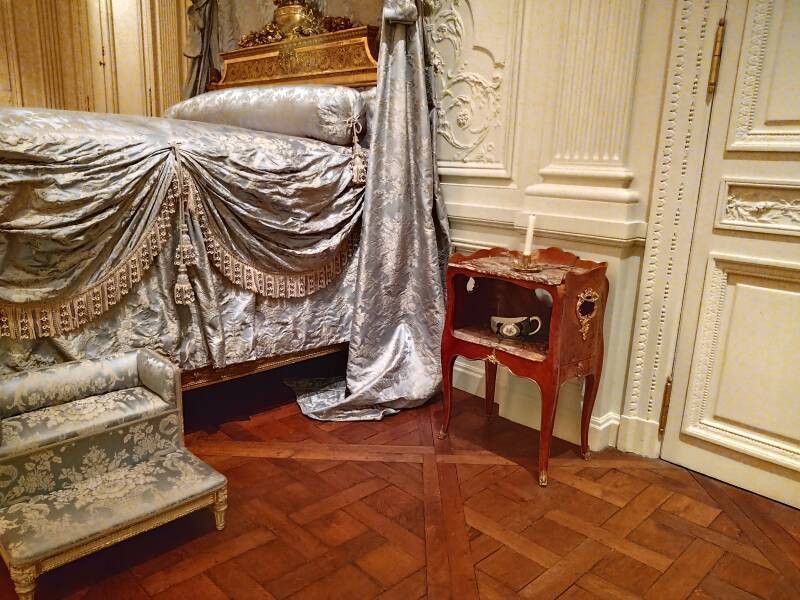
French chamber pot from 1757–1758, soft-paste porcelain from the famous Sèvres factory.
The French loan word toilette first appeared in English around 1540. It referred to the small cloth draped over one's shoulders by a hairdresser. Through the late 1600s, both French and English came to use the term to mean daily grooming and preparation, and the associated furniture and equipment.
The French term cabinet de toilette meant the room in which this daily toilette ritual happened. 1819 brought the first attested use of "toilet" in English to mean a room dedicated to grooming. It had to do only with washing your face, combing your hair, etc. Then it became a euphemism vaguely referring to a space for urinating and defecating. With the availability of cast-iron and porcelain commodes replacing chamber pots in the mid to late 1800s, those plumbing fixtures came to be called toilets. The original sense of the word "toilet" as pertaining to grooming, with the exception of the variant "toiletries", disappeared from English in the early 1900s.
That's right, originally "toilet" was the word you said to avoid referring to a bodily function. But now we say something else to avoid saying "toilet"!
Groom of the King's Close StoolThe palace of Versailles during the reign of King Louis XIV (1643-1715) had 2000 rooms but just one toilet. Royalty had a close stool, a chair or stool with a hole through its padded seat, with a chamber pot beneath or enclosed inside. It was tended by someone with a title like Groom of the King's Close Stool. Of course, royalty has always had different toilet rules.
The French kings would host feasts with up to 10,000 guests at Versailles, all of them relieving themselves in the gardens. A visitor complained in 1764 of "the evil odor of the park and gardens of the castle."
Waste in large cities like London and Paris often ran down a channel in the center of the street. In 1730 the first closed sewer was built in Paris, running along 300 meters of Rue Monmartre.
A city in southeastern Britain was growing around the site of a large Roman complex of thermal baths established in 60 AD. The English had came to call the town Bath. By the 1700s, a few people began considering regular bathing as healthy, or at least not dangerous. In 1742 the Mineral Water Hospital opened in Bath. Maybe hygiene wasn't so dangerous after all.
Public Toilets Slowly Reappear in Europe
After the French Revolution there was: Liberté, égalité, fraternité, et un peu de l'assainissement! That is, at least a little sanitation. Paris had eight public toilets in 1820. The alternative, available in many European cities around 1800, was to hire a pot and large cloak from one of the entrepreneurs offering this service in busy public areas. You could squat over the pot with the cloak hiding the details.
Berlin's first public toilet of the modern era seems to have appeared in 1820.
History of theFlush Toilet
Alexander Cummings, a Scottish general mechanic and tinkerer, obtained the first English patent for a flush toilet design in 1775. His important innovation was the trap, an S-shaped double bend in the waste pipe forming an air lock to isolate the sewer gases down in the waste pipes from the air in the room.
Just three years later, Joseph Bramah of Yorkshire patented a hinged flap valve for the flush tank, making a flushing water closet design much more practical.
In 1846 a French public health professional estimated that a force of 200 to 250 workers cleaned 100 cesspits every night in Paris, out of a total of 30,000 cesspits in the city.
The 1848 Public Health Act in England greatly benefited both public health and the sanitation business. It required every new house to have a "water closet, privy, or ash-pit, furnished with proper doors and coverings". So, the law required the availability of plumbing and privacy. The Public Health Act placed water supply, sewerage, drainage, and paving under the authority of a single local government body. Something was needed, as 55,000 people died of cholera throughout Britain that year, 14,000 of them in London.
William Jennings was the most prominent 19th century British public toilet designer, famous for his "Monkey Closet" design in the "Retiring Rooms" of the Crystal Palace during the 1851 Great Exhibition. During the Great Exhibition, May 1st through October 15th of 1851, 827,280 exhibition visitors (all of them male, of course) paid one penny to use the Retiring Rooms. The penny got them a clean toilet seat, plus a shoe shine and the use of a towel and a comb. "To spend a penny" entered the English lexicon of euphemism.
In 1854 Doctor John Snow discovered the connection between a cholera outbreak in London and a water pump contaminated by nearby cesspits. These pits were about one meter across and two to three meters deep, lined with loose stones or brick. Solids would sink and accumulate, requiring occasional digging out by "gong farmers". Liquid seeped out into the surrounding soil and carried micro-organisms laterally to nearby wells. However, "miasma" or "bad air" continued to be the preferred explanation into the 1880s, when modern theories of contamination and epidemiology finally started taking hold.
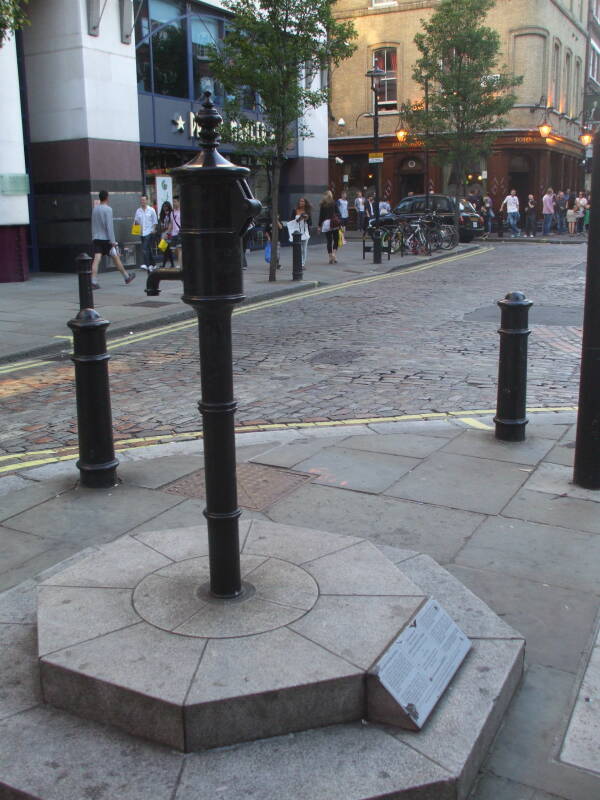
A replica of the Broad Street Pump in Soho, discovered by John Snow to be the source of a cholera outbreak.
Also in 1854, Jennings designed the first permanent public underground toilet at the Royal Exchange. London was densely settled, so public toilets went underground. Stairs led down from the sidewalk, and light was provided by skylights.
Most of the public toilets were for men only, based on the Victorian era theory that if women did suffer from bodily excretions, they certainly wouldn't do such a thing outside the home. This only caused and reinforced what it claimed to predict. Women could only venture a limited distance from home because eventually anyone has to use a toilet.
Toilets were appearing, so a central sewage collection system was needed. London's sewer system was begun in 1859 under the direction of the civil engineer Joseph Bazalgette. The six main interceptor sewers totaled 100 miles in length, carrying sewage downstream from London to the Thames estuary. Some 450 miles of primary sewers connected to the main interceptors, emptying the output of some 13,000 miles of smaller local sewer lines.
Chicago and Brooklyn got the first U.S. sewers in the late 1850s. Frankfurt am Main got a sewer system in 1863.
Thomas Crapper was a latecomer to the business, only opening his plumbing business in 1861. The second half of the 19th century was a boom time for plumbing.
In 1872 the municipalities in France requested proposals from private companies interested in managing public toilets on a 20-year contract.
Selfridge's department store, designed and operated by the American retailer Harry Gordon Selfridge, opened in 1909 on Oxford Street in London. Selfridge pioneered several retail concepts that still dominate the economy, including the idea of shopping for pleasure rather than purely out of necessity. The store incorporated London's first public toilets and washrooms for women.
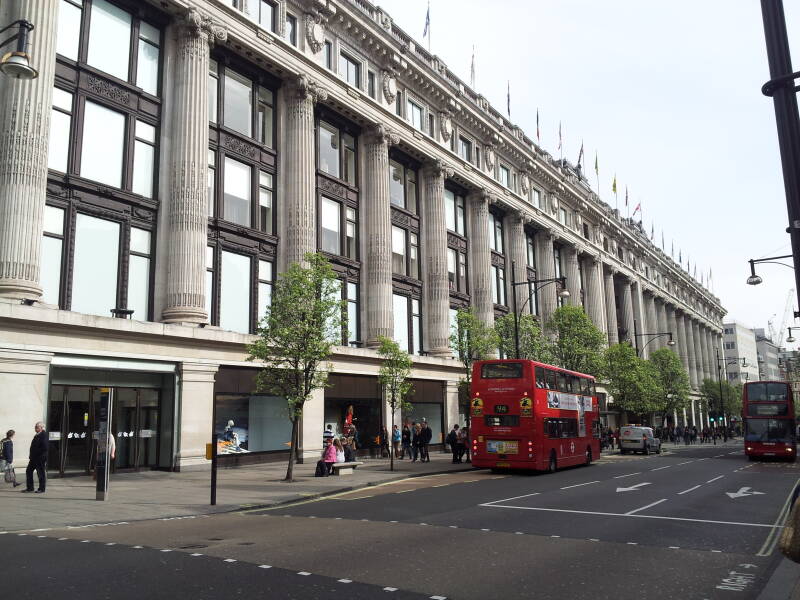
Selfridge's department store on Oxford Street, site of London's first public toilets for women.
Public toilets, both free and with a fee, flourished in Britain through the early and mid 1900s, but then they became more expensive to maintain. The first pay toilet in the U.S. had been installed in 1910 in Terre Haute, Indiana. By the 1970s there were an estimated 50,000 pay toilets in the U.S., most of them stalls with coin-operated locks manufactured by the Nik-O-Lok Company.
This continued the discrimination against women in public toilets, as they always had to pay for a stall while men could use urinals for free. Chicago banned pay toilets in 1973, and several states passed similar bans through the 1970s. Pay toilets remain common outside the U.S. and Canada, especially in train stations and bus stations.
The end of les dames pipi, the women who cleaned free public toilets in ParisThe New York Times
Public toilets began to disappear. An article in the Times of London in 1980 reported that 73 toilets and 9 urinals in the Westminster district cost £516,960 (or US$756,000) to run in 1970, but £1,580,000 (or US$2,300,000) in 1979, three times the cost nine years later.
The Victorian horror of the body and its functions had encouraged the trend of hiding the facility out of sight underground. To this they added an internal layout that further hid everything from sight within the facility as much as possible. In the late 20th century that design led to increased levels of drug use, public sex, and assaults and other crimes. The London Tourism Board reported that the expense and the unwanted uses had led to 25% of the public facilities for men closing between 1966 and 1977.
In 2002 the British Toilet Association announced that 47% of the remaining public toilets in England had closed over the preceding eight years. Most of the underground toilets have been closed, as they were more prone to vandalism and weren't accessible by the handicapped. A single public toilet can cost £52,000 per year to maintain, and a standard block with four cubicles for women, one cubicle and urinals for men, and a disabled access toilet would cost over £140,000 to build. Many public toilets were closed in the early 21st century and modified into coffee shops, bars, night clubs, and other businesses.
Language reveals shifting attitudes. The neccessarium of the medieval era is now a convenience. Long ago, we had to have it. Now it's nice to have if it can be afforded, but it's not a requirement.
Language also demonstrates the squeamishness about calling a toilet a toilet. A shared public or industrial facility with toilets and hand-washing is a "washroom" in Canada and a "restroom" in the U.S., while private facilities in homes or hotel rooms are "bathrooms" in both those countries. You might go into a washroom just to wash your hands, but I don't know what Canadians would call a small room containing nothing but a sink. Meanwhile, an American asking "Where is the bathroom?" in a restaurant clearly isn't planning to take a bath. Nor would they go to the restroom to rest. "Lavatory" dresses things up in Latin, but again the term is literally about nothing but washing. More roundabout euphemisms are the early-to-mid-20th-century "powder room" for the women's toilets, the "loo", and the vagueness of the rooms referenced by "the gents' room", "the ladies' room", and "the comfort room". The room with the toilet in France is often labeled "W.C.", an abbreviation for the vague English term "water closet". Does that refer to the tank holding the flushing water, to the complete toilet, or to the room in which it's located?
Moving into privacy, this will vary enormously from one culture to the next. My observations are mostly from Europe and the U.S. In today's China, for example, I know that there is much less privacy in public restrooms. Below is a public men's room at the Memorial to the Martyrs park in Guangzhou.
Private Space in Public Toilets
As described above, the earliest archaeological remains of sanitary systems are of public infrastructure for private toilets. Shared drains go back to the Neolithic era in Orkney, appearing again in the Indus Valley, Mesopotamia, Mycenae, Phrygia, Minoan Crete, and Delos.
The first true public toilets in Europe and Asia Minor, by which I mean facilities for multiple simultaneous users from the general population, appeared in Greece and increased in number and sophistication under Roman administration.
Elite Romans wanted to avoid mixing with the lower classes, and so they used chamber pots in their homes. But the general population of Rome seem not to have cared about privacy in the latrine. Seated on a bench to defecate with their togas draped around them, everyone knew what they were doing but they weren't really exposed.
Almost everyone wants some privacy, from a Roman with a draped toga to a medieval European with an enveloping cloak. For the lower classes in Europe, there wasn't much privacy at all. There were no dividers between seats within the houses of easement. Lower-class people defecated in the bushes and partially sheltered corners between buildings in order to get some privacy. The middle classes had chamber pots which they could use in their sleeping quarters and then dump the contents in the street.
The development of the mass-produced flushing toilet made from cast iron or porcelain coincided with the Victorian era. Public facilities with individual toilets became available for men, but there were almost none for women. They were expected to stay within the home and avoid the corruption of the public toilets.
About one billion people, or 15% of the world population, practice open defecation, squatting in fields, rivers, shared open trenches, and open parks. 82% of open defecation happens in just 10 countries, with the top five being India (around 600 million people), Indonesia (54 million), Pakistan (41 million), Nigeria (39 million), and Ethiopia (34 million). It's a serious problem for public health, as well as for personal dignity. It may happen because there simply are no toilets available. Or some toilets may be available but they are filthy or foul-smelling, or their location brings a risk to personal safety, or their location and design makes them less private than open defecation in a nearby field.
A multi-user public toilet, especially a men's facility, has certain implicit expectations of behavior — maintaining some minimal physical separation, no eye contact, no conversation. A study published in the British Journal of Criminology in 2012 used observation and interviews to assess behavior and psychology in public restrooms. It found that women are at ease in public restrooms, complaining mostly about cleanliness. But men tend to be on edge. The study concluded that men tend to worry about being watched by other men, or being perceived as watching other men, feeling that either case makes them a potential target of sexual violence.
Today many visitors to the U.S.A. notice the lack of privacy in public facilities, especially when compared to Europe. European toilets are typically in a "cabin" or a completely enclosed tiny room. In the U.S.A., there are only flimsy partitions extending from a little below your knee to about eye-level. There are gaps around the doors and their latches often allow a door to swing open when someone bumps the panel in an adjacent stall. The facilities are intentionally designed to limit privacy.
Schools usually have no toilet stall doors at all, just panels between the toilets. This is to discourage smoking and other drug use plus sexual activity ranging from masturbation to rape. The school I attended considered itself progressive as it had a separate junior-high smoking area. That meant that the children in 7th and 8th grades could smoke tobacco in peace without being intimidated or picking up any bad habits from the 9th through 12th graders who were smoking in their own area. And, of course, even with these multiple smoking areas for the children, there were no toilet stall doors.
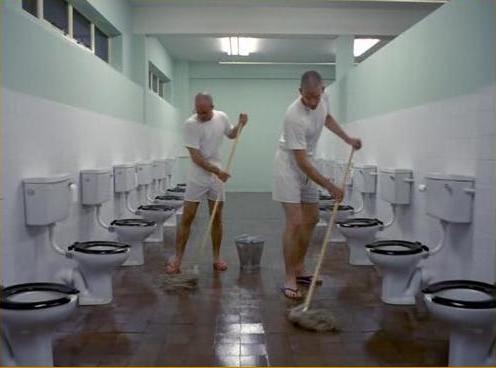
Latrine scene from Full Metal Jacket.
The most extreme lack of privacy (at least in the U.S.) is in the military, where barracks for basic training have no partitions at all in the latrines. This is part of indoctrination, replacing individualism with group membership.
Amazon
ASIN: B0091X2K0A
Gender Segregation of Public Toilets
The Romans didn't care much about privacy in their shared latrines, and men and women used them together. Medieval European garderobes and houses of easement provided little to no privacy, regardless of what their users may have wanted. The prevalence of open defecation in that period indicates that many people didn't find that the shared public facilities were much of an improvement over semi-public spaces.
It was a remarkable innovation when a ball in Paris in 1739 included toilets set aside for both men and women. One room for men, one for women, each with a chamber box (that is, a chamber pot in a box with a seat on the top). The guests at the ball are reported to have found this eccentric and fun.
By the time public toilets were finally reappearing in northwestern Europe in the mid to late 1800s, it was the Victorian period. In order to protect women, the almost complete lack of public women's facilities kept them confined within the home. The public toilets and washrooms for women in Selfridge's department store in 1909 were a real revolution.
Women were making up more and more of the factory work force, and more fundamentally, simply venturing out into public. There were soon separate reading rooms in public libraries (because we all know how rowdy the men's reading room can become), separate entrances at banks and post offices, separate waiting rooms at train stations, and other separated spaces to "protect the Weaker Sex".
At the same time, the medical profession was using "female hysteria" as a catch-all diagnosis. One physician claimed in 1859 that a quarter of all women suffered from hysteria. Another assembled a seventy-five page list of the possible symptoms of female hysteria and then claimed that this list was incomplete.
There was a common belief that the stresses of modern life in the mid to late 1800s supposedly caused women, at least those "in civilized countries", to be more susceptible to the nervous disorders assembled under this umbrella term, and to be more likely to develop faulty reproductive tracts.
Houses were commonly designed to include "fainting rooms" in which "fainting couches" were installed. Fainting, especially among women, was much more common during the second half of the 19th century. Most of this was a cultural trend, a mass psychogenic syndrome with people crying out, swooning, and falling to the ground in over-reaction to any slightly startling event. Fainting in general, and "female hysteria" diagnoses in particular, quickly decreased through the early 1900s. Meanwhile the fainting couches had been commonly used for so-called pelvic massages administered by physicians making weekly housecalls to alleviate all the female hysteria. Technology soon took the place of manual massage. This book from Johns Hopkins University Press explains some of what was going on with all the "hysteria".
Amazon
ASIN: 0801866464
Amazon
ASIN: B071FCKGHN
In 1878, Rose Adams of the Ladies Sanitary Association urged London churches to provide public toilets for women.
In 1887, the state of Massachusetts passed the first law in the U.S. segregating toilets by sex. Any business with female employees had to have a restroom just for the women. Several other states quickly passed similar laws. By the 1920s most of the states had laws requiring sex-segregated restrooms. For details see "Workplace Restroom Policies in Light of New Jersey's Gender Identity Protection" in the Rutgers Law Review.
A 1903 Department of Labor bulletin is quoted as saying that restrooms for factory workers should be segregated by sex so as to provide "a protective haven... where a woman could seek comfort and rest when her weak body gave out on the job." The facilities all had to be carefully screened to provide adequate privacy for bodies and bodily function. A 1913 Department of Labor publication stated that close proximity of men's and women's restrooms with imperfect soundproofing would be "morally objectionable."
Many of these laws dating from 1890 through the 1920s and still in force are worded so that a business must have one restroom for men and another for women. In many locales, a business must have one room labeled "Men" and another (usually with what should be an unnecessary queue) labeled "Women". If they have two small rooms, each with a toilet and sink and simply labeled "Restroom", then they are in violation of the law. If there is only one single-person room, then it's even worse. By the Victorian era logic, of course a woman could not use a facility that men used before or after her, and therefore, by a literal reading of the outdated law, women have no toilet available there.
The century-old laws assume that women don't go out in public very much. According to this 1988 Ph.D. thesis in Housing, Interior Design and Resource Management:
Currently, the three major model plumbing codes (BOCA, Southern Standard, and Uniform) in the United States specify minimum elimination fixture requirements (water closets and urinals) for men's restrooms that are often greater than the number for women's restrooms (The BOCA Basic/National Plumbing Code 1987, 1986; Standard Plumbing Code, 1985 Edition, 1985; Uniform Plumbing Code, 1985 Edition, 1983) depending on the type of facility, the specification formula used, and the manner in which the designer specifies the fixtures.
U.S. public restrooms are overseen by two federal agencies. Those for the employees in workplaces are regulated by the Department of Labor, those for non-employees by the Department of Health and Human Services. The Department of Labor regulations are in 29 CFR 1910.141. The Department of Health and Human Services has regulations for toilets in food packing plants (21 CFR 110) in pharmaceutical manufacturing plants (21 CFR 211), on board interstate aircraft and trains (21 CFR 1250), and in other specific locations, but nothing obviously about public toilets in general.
Amazon
ASIN: B01KUZT6R2
Amazon
ASIN: B003BEDURW
Privacy and safety from sexual assault are vital issues, of course. Amnesty International's list of measures to ensure the safety and thus participation of girls in schools includes segregated toilets. The intentional lack of privacy within U.S. public restrooms means that there must be two fully duplicated facilities.
Strict gender segregation causes problems for people taking care of dependents of the opposite gender, including children, the elderly, and the physically and mentally disabled. In the 2000s, many public facilities like airports began to add "family restrooms" for this purpose.
In the mid 2010s, transgender restroom concerns became national political issues in the U.S. The political arguments were, as to be expected, somewhat disconnected from reality.
Sex is hardware. Genes and genitals. Sex is whether a human's 23rd chromosome pair is XX or XY. This should lead to clearly distinguishable genital form, although incomplete or unusual development may lead to indistinct or ambiguous genitalia.
Gender is software. Behavior and perceptions. This is an individual's personal psychology and self-perception. An individual's perception of their gender may disagree with their chromosomal sex, in which case the term transgender is appropriate. (Whereas a transsexual person has had, or is undergoing, hormonal treatment and sex-reassignment surgery, while a transvestite is someone who enjoys dressing as the opposite sex, and heterosexual versus homosexual is something else entirely)
A number of jurisdictions have laws permitting people to use the public restroom agreeing with their gender identity. Many colleges have established what are frequently called unisex public toilets. However, "pan-gender" would be better terminology, as this is about identity, not chromosomes or genitalia. Besides, it's a facility for all genders, so pan- from the Greek παν-, and not uni- meaning just one. I approve of the labeling of the public restrooms at the Whitney Museum in New York:
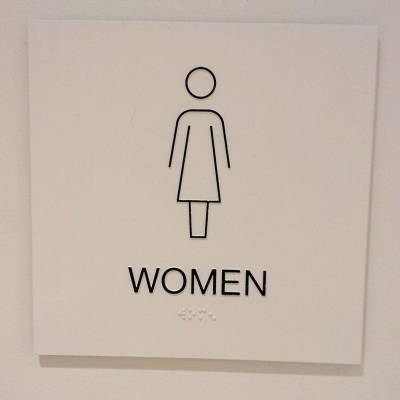
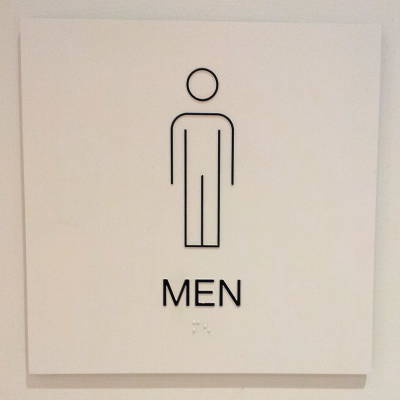
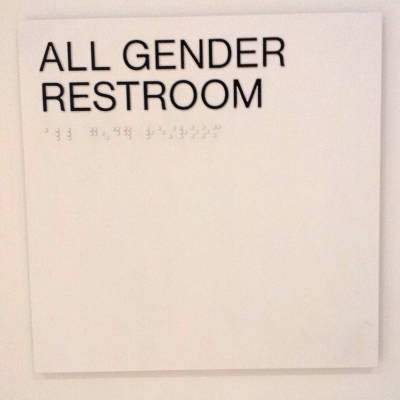
Several cities (including Washington D.C., Philadelphia, Seattle, Austin, and San Francisco) have passed laws requiring single-occupancy restrooms in public spaces to simply be single-occupancy restrooms with no restrictions as to who uses them.
RefugeRestroom
Refuge Restrooms is a directory of unisex and handicapped accessible public restrooms. Several cities and colleges have their own localized list.
The below example of a general-purpose public restroom is from Heavilon Hall at Purdue University. There is a pair of restrooms labeled "Men" and "Women" on each floor of the building, except in the basement where building infrastructure got in the way of one of the two. So there's a single restroom with a locking door.
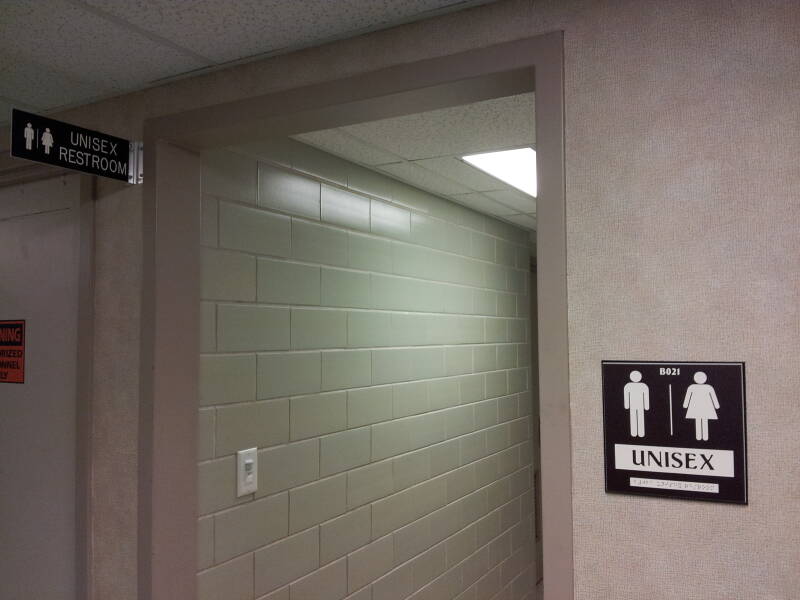
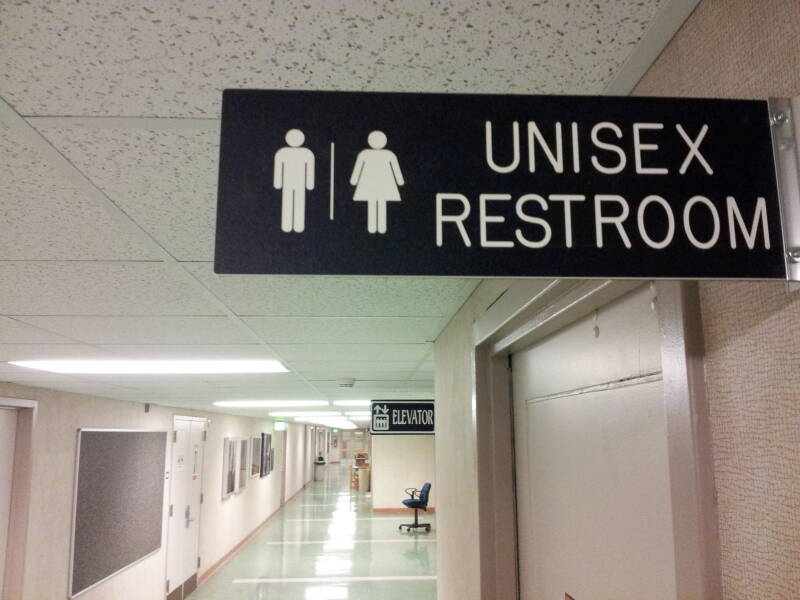
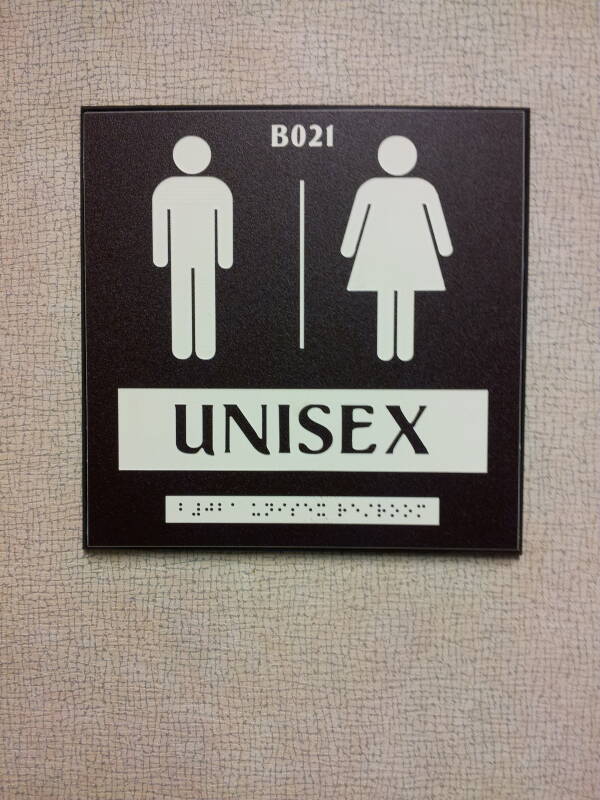
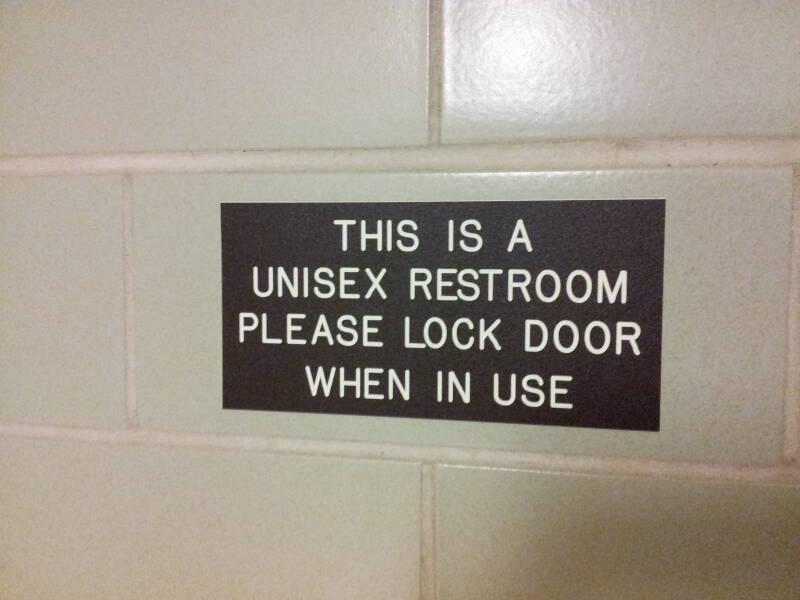
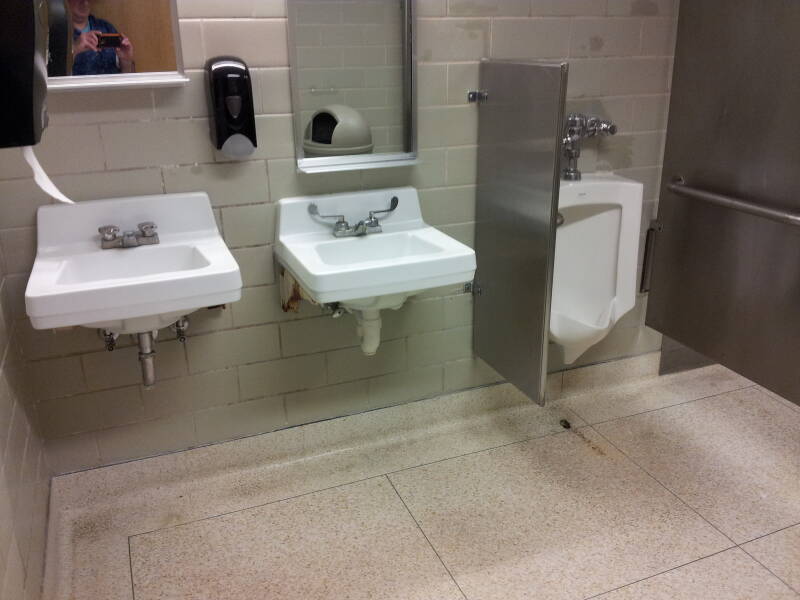
Once you get inside, it's pretty bland. Two sinks, a urinal, a handicap-accessible toilet, and a fold-down baby-changing table.
The only thing at all unusual or interesting is that the janitor's storage closet is through a door that you access through the toilet stall, making this one of the few toilet stalls with two doors.
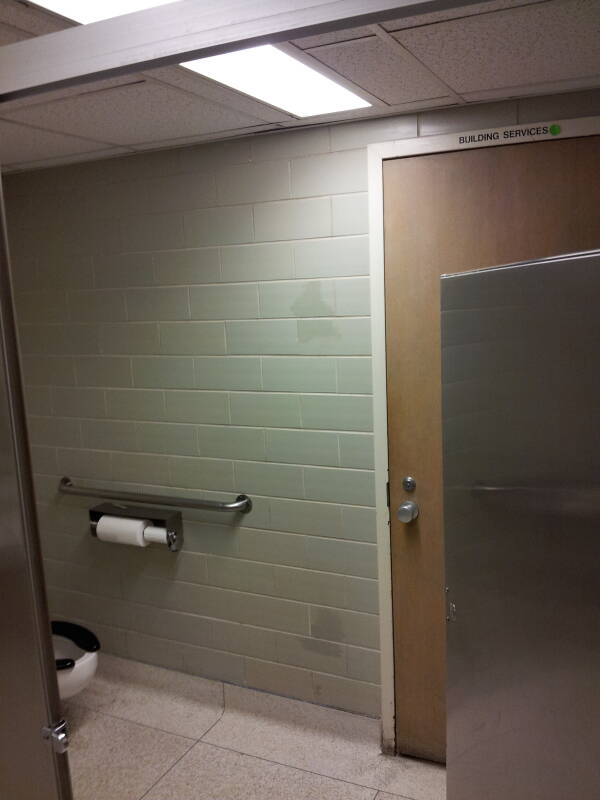
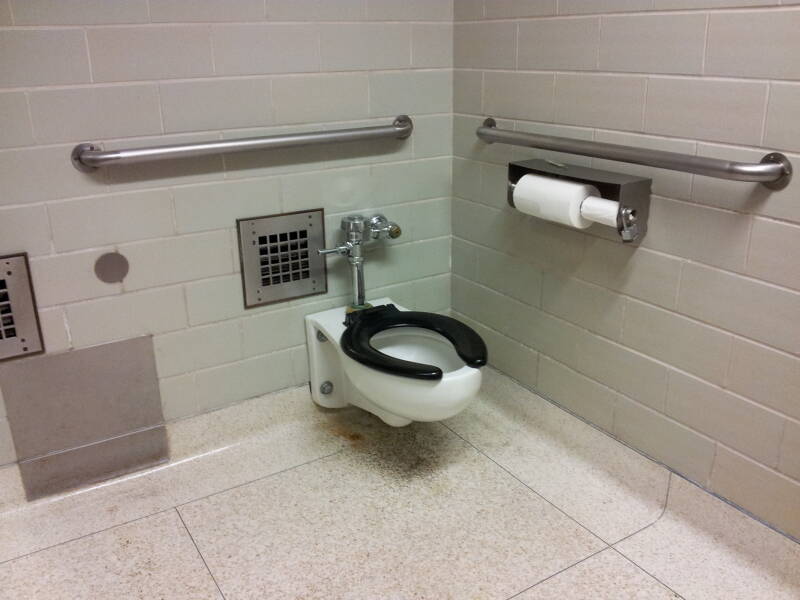
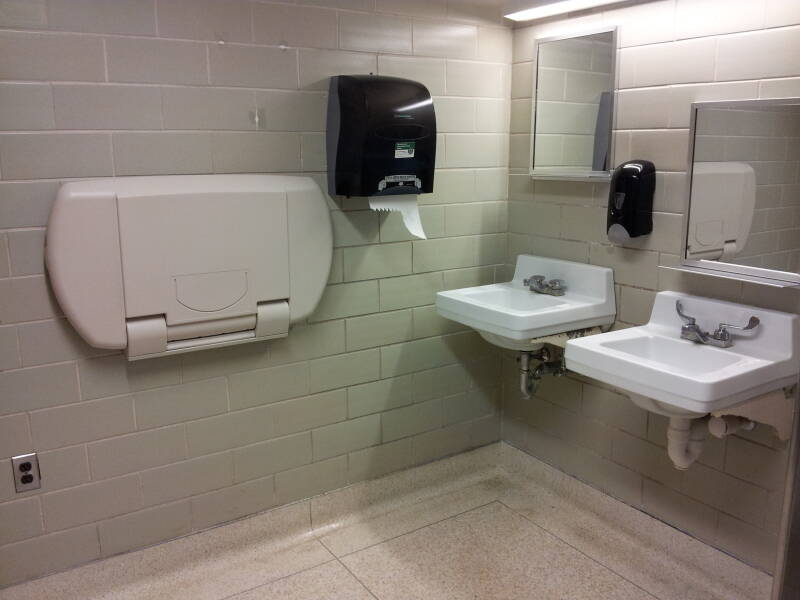
Here is another unisex restroom at Purdue University, room 017 of the Electrical Engineering building. It's one large tiled room with no dividers, like the klizma chamber in the Russian hospital.
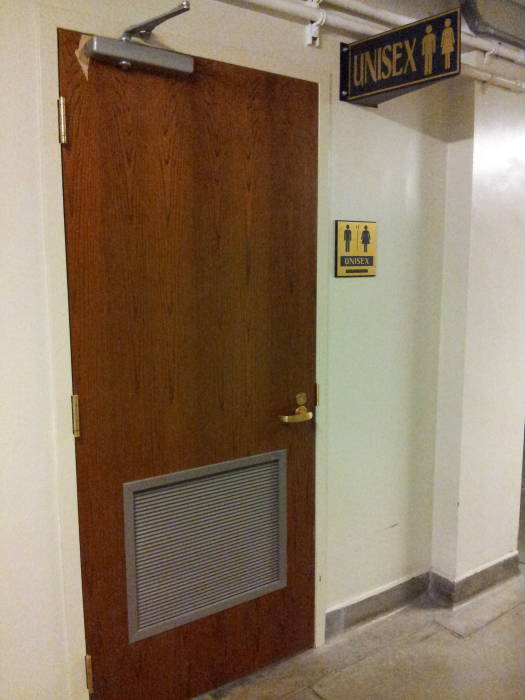
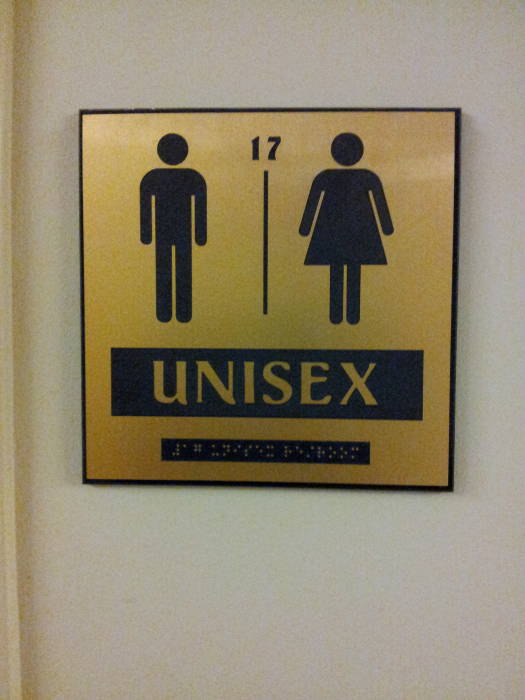
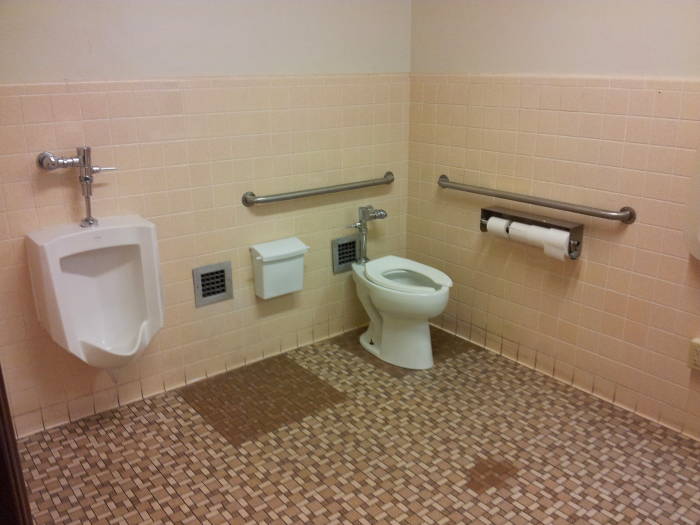
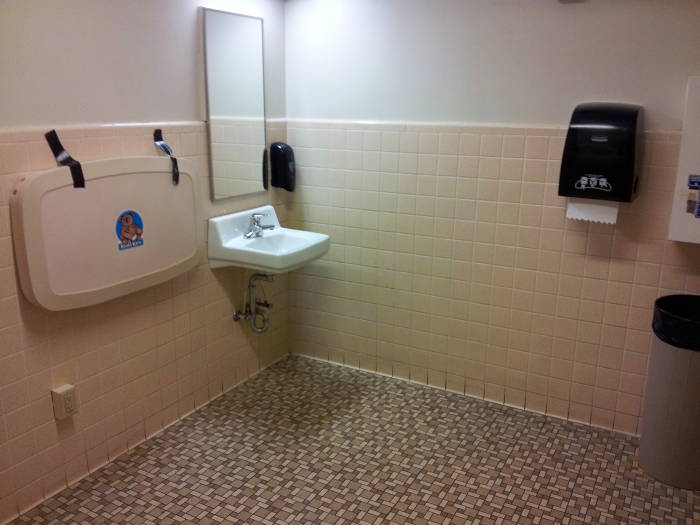
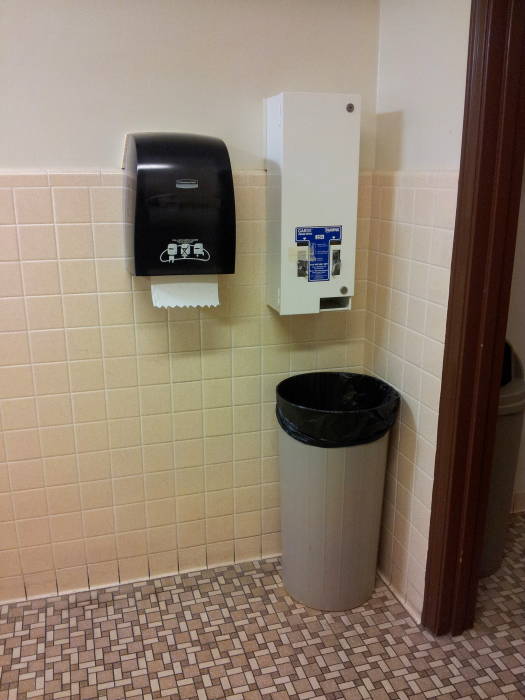
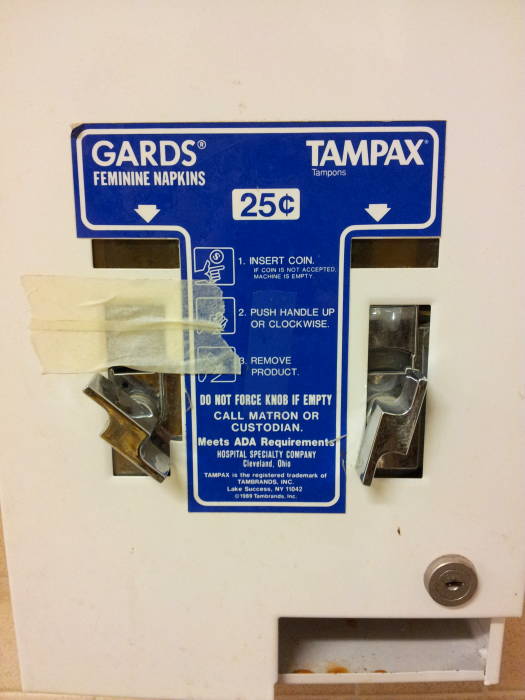
Amazon
ASIN: B002MBW026
Amazon
ASIN: B00700KLL6

Mug shot of U.S. Senator Larry Craig (R-ID), who looks like a man, self-identifies as a man, dresses as a man, and has been arrested for homosexual activities in men's restrooms.
In 2016, the state of North Carolina passed a law over-riding local anti-discrimination laws and restricting people to the use of public restrooms matching the sex recorded on their birth certificates. So that means that no one can legally use a public restroom in North Carolina unless they are carrying their birth certificate, as the North Carolina Bathroom Police might be checking papers.
A number of other states, counties, and cities quickly banned publicly-funded travel to North Carolina. The U.S. Department of Justice notified North Carolina that the state bill violates Title VII of the Civil Rights Act and Title IX of the Education Amendments of 1972.
Similar "Bathroom Bills" were proposed in Arizona, Illinois, Kansas, Kentucky, Massachusetts, Minnesota, Mississippi, Missouri, Nevada, South Dakota, Tennessee, Texas, and Wisconsin during 2013-2016.
The supporters of these laws regulating access to public restrooms cite the need to prevent sexual predation. However, their example scenarios have nothing to do with gender dysphoria, but instead are about pedophilia and both homosexual and heterosexual rape by men. Those crimes should be stopped, but they are already illegal and these bathroom laws would be of no help. The American Civil Liberties Union did some research and found that there simply wasn't any record of a sexual assault committed in the U.S. by a transgender person using the public restroom corresponding to their gender identity.
Meanwhile, the "Jim Crow" laws so common until recently in North Carolina and elsewhere across the south could require all non-white people to use one "Colored" restroom. So, they don't see gender mixing as entirely bad, just so long as the White People aren't involved.
The book Better Off Without 'Em makes a strong case for talking the South into seceding again. Or, simply kicking them out.
